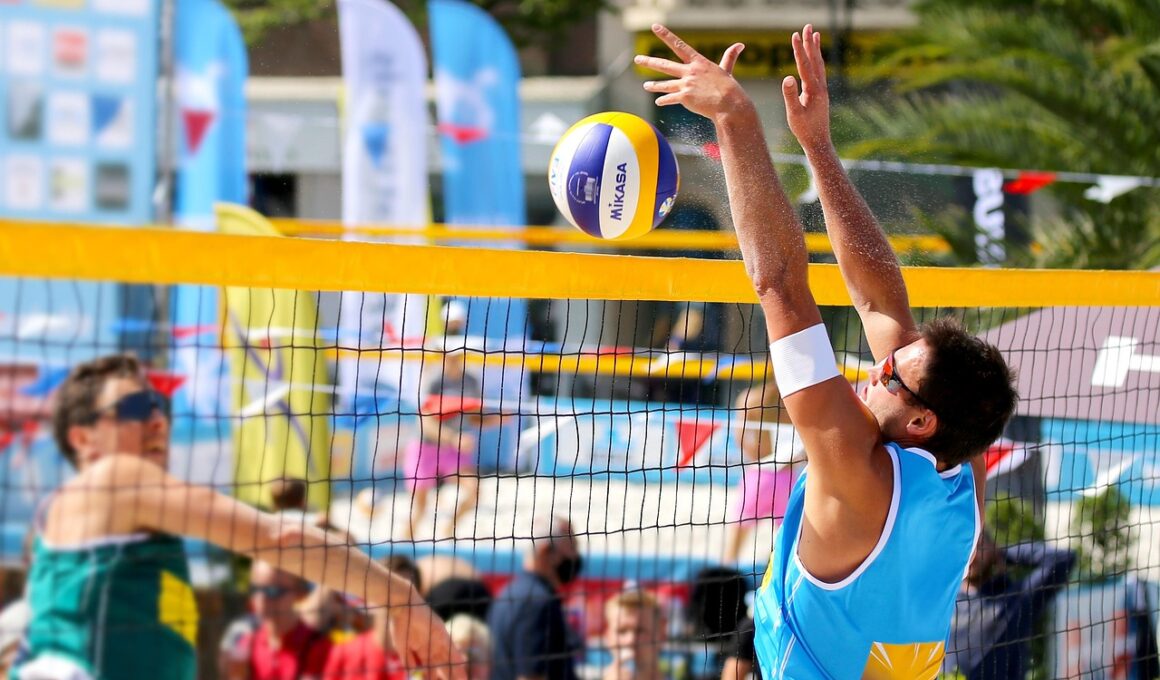Hand and Wrist Biomechanics in Volleyball: Enhancing Serve Power
In the fast-paced game of volleyball, the biomechanics of the hand and wrist play a crucial role in executing powerful serves. Understanding the unique mechanical properties of these joints is essential for athletes aiming to increase their serve speed. The hand functions as a complex tool, leveraging anatomical structures to generate force. Muscles, tendons, and ligaments work in synergy, allowing players to apply optimal pressure while serving. By focusing on the biomechanics involved during the serve, athletes can improve their performance significantly. Additionally, aligning proper technique with anatomical knowledge aids in injury prevention. This knowledge highlights the importance of training not only for strength but also for flexibility and control. Developing wrist and hand strength enhances grip and precision, directly impacting the trajectory of the volleyball. Furthermore, specific exercises focused on the wrist flexors and extensors can lead to noticeable improvements. Coaches are encouraged to incorporate drills that enhance coordination and timing in serving motion. A comprehensive approach that combines physical and technical training ensures players are not only robust but also skilled in their serving strategies.
Analyzing the kinematics of the wrist during a volleyball serve can reveal important insights into performance. Kinematics refers to the study of motion without considering the forces that cause it. In volleyball, the wrist undergoes significant movement as players transition through the serve. The range of motion in the wrist allows for a whipping action that can exponentially increase ball speed. Utilizing motion analysis technology, coaches can observe the angles and velocity of the wrist during serves. These metrics help inform training regimens to target specific deficiencies in a player’s serving technique. Additionally, understanding the functional anatomy of the wrist contributes to developing personalized workout plans. Players interested in optimizing their serve mechanics should focus on achieving maximum wrist flexion and extension during takeoff. Incorporating drills that stress this motion can lead to improved serve accuracy and power. A well-designed strength training program should therefore emphasize wrist stabilization exercises. Both gradual and explosive movements can enhance players’ overall strength and agility. Observational videos of skilled servers can also offer valuable learning opportunities, allowing athletes to visualize effective wrist dynamics during a game scenario.
The Role of Strength Training
Strength training is vital in enhancing serve power through developing the musculature surrounding the hand and wrist. Targeting specific muscles can lead to improved functional mechanics, which is crucial for effective serving. Strengthening the forearm muscles contributes to better grip and wrist stability. This stability allows for an efficient application of force against the ball, ultimately enhancing the velocity of the serve. Exercises such as wrist curls and reverse curls are excellent for building strength in these areas. Additionally, integrating resistance bands can further promote wrist stability and control. This dynamic training method incorporates resistance patterns that are valuable for serving athletes. Moreover, plyometric exercises can improve explosive power, vital for a high-impact serve. Athletes should also focus on balance and coordination, which play a significant role during the critical moment of ball contact. Improving overall hand-eye coordination through various drills can significantly impact serve precision. By combining strength with coordination exercises, athletes are better equipped to execute powerful serves consistently. Consequently, developing strength in the wrist ensures athletes maintain proper form even under pressure, enhancing both performance and injury resilience in volleyball matches.
In addition to strength training, flexibility exercises are equally important for enhancing hand and wrist functionality in volleyball. Flexibility directly influences the range of motion and effectiveness of the serve. A flexible wrist can compress and extend more effectively during the serving motion, allowing for increased ball speed. Therefore, incorporating regular stretching routines into training can significantly enhance serve efficiency. Stretching exercises focusing on the extensor and flexor muscles of the forearm promote greater flexibility. Furthermore, dynamic stretching before practice helps to prepare the wrist for explosive movements. Incorporating yoga or pilates into a training schedule can also support overall flexibility. These practices promote better joint health and increase muscle elasticity. Enhanced range of motion can lead to a smoother serving technique, resulting in improved serve execution. Ensuring athletes maintain a consistent post-training stretching routine helps prevent stiffness and promotes quicker recovery. Evaluating a player’s flexibility regularly through fitness assessments can provide feedback regarding training efficacy. Overall, regular flexibility training, when combined with strength training, enables volleyball athletes to achieve optimal biomechanics during serves, resulting in a more effective playing style.
Injury Prevention Strategies
Injury prevention is an essential aspect of any training program focused on hand and wrist biomechanics in volleyball. These areas are particularly susceptible to injuries due to repetitive movements and intense demands of the game. Common injuries include sprains and strains of the wrist, which can sideline athletes for extended periods. Therefore, educating players on proper serving techniques is paramount to avoiding these injuries. Athletes should practice proper warm-up exercises to prepare the muscles and tendons. Engaging in functional movement screening can also help identify potential risk factors. Strengthening exercises targeting supporting muscles around the wrist can lower the risk of injuries. Additionally, utilizing kinesiology tape can provide support and proprioceptive input to the wrist during dynamic movements. Athletes should also be aware of their fatigue levels, as overtraining can lead to compromised mechanics. Monitoring serving techniques during practice sessions allows coaches to provide immediate feedback on form. Furthermore, encouraging a balanced training routine that includes rest days allows for adequate recovery times. Prioritizing injury prevention strategies ensures athletes remain in peak condition while maximizing their performance potential throughout the volleyball season.
Nutrition is another critical factor that influences hand and wrist biomechanics for volleyball players. A well-balanced diet supports muscle recovery and energy levels essential for high-intensity training. Incorporating nutrients that promote muscle repair, such as protein, is particularly beneficial post-workout. Hydration also plays a significant role in maintaining performance; dehydration can lead to decreased strength and functional ability. Ensuring players maintain a sufficient fluid balance is necessary for optimal muscle control. Additionally, micronutrients, including vitamins C and E, are essential for maintaining joint health. Foods rich in omega-3 fatty acids can reduce inflammation, supporting healthier joints. Athletes should consider working with a sports nutritionist to develop tailored meal plans that support their unique energy needs. Supplements may also enhance joint and tissue health; however, consulting a healthcare professional is advisable. Finally, meal timing can influence the efficacy of nutrient absorption, ensuring energy is available before training sessions. By emphasizing nutrition in their training program, athletes can optimize hand and wrist biomechanics, improving serve performance and overall physical resilience. Integrating nutrition education into coaching can empower players to make informed choices about their diet.
Conclusion
In conclusion, mastering hand and wrist biomechanics is pivotal for enhancing serve power in volleyball. By focusing on strength, flexibility, and proper technique, athletes can significantly improve their overall performance. Regular training that combines strength exercises with flexibility routines ensures a well-rounded approach to serve mechanics. Furthermore, integrating injury prevention strategies alongside proper nutrition is key to sustaining long-term athletic performance. Coaches and athletes alike must prioritize education around biomechanics, helping players understand their bodies and movements better. Utilizing technology for analysis and feedback can greatly enhance training effectiveness and performance outcomes. Ultimately, by recognizing the importance of hand and wrist biomechanics, volleyball players can develop a powerful serve while minimizing the risk of injury. Fostering a comprehensive understanding of these concepts leads to enhanced gameplay and athlete longevity in the sport. As volleyball evolves, ongoing research into biomechanics continues to provide valuable insights for players aiming to elevate their game. A commitment to improving hand and wrist dynamics will not only enhance individual serve capabilities but also contribute to successful teamwork on the court.
In the fast-paced game of volleyball, the biomechanics of the hand and wrist play a crucial role in executing powerful serves. Understanding the unique mechanical properties of these joints is essential for athletes aiming to increase their serve speed. The hand functions as a complex tool, leveraging anatomical structures to generate force. Muscles, tendons, and ligaments work in synergy, allowing players to apply optimal pressure while serving. By focusing on the biomechanics involved during the serve, athletes can improve their performance significantly. Additionally, aligning proper technique with anatomical knowledge aids in injury prevention. This knowledge highlights the importance of training not only for strength but also for flexibility and control. Developing wrist and hand strength enhances grip and precision, directly impacting the trajectory of the volleyball. Furthermore, specific exercises focused on the wrist flexors and extensors can lead to noticeable improvements. Coaches are encouraged to incorporate drills that enhance coordination and timing in serving motion. A comprehensive approach that combines physical and technical training ensures players are not only robust but also skilled in their serving strategies.


